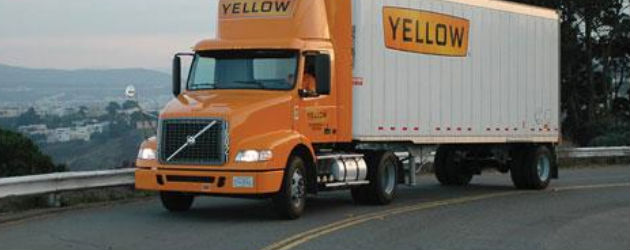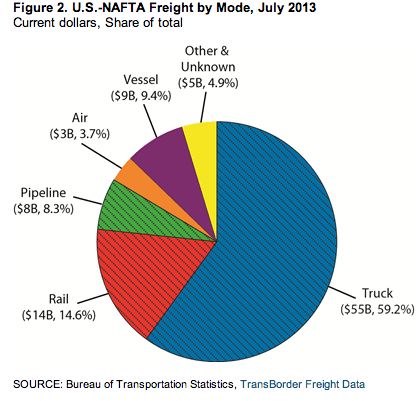U.S. Trade with NAFTA Partners Up 6.3 Percent
 Four of the five transportation modes carried more U.S.-NAFTA trade in July 2013 than in July 2012 as the value of overall U.S. trade with its NAFTA partners rose 6.3 percent from year to year, according to data released by the Bureau of Transportation Statistics (BTS) of the U.S. Department of Transportation.
Four of the five transportation modes carried more U.S.-NAFTA trade in July 2013 than in July 2012 as the value of overall U.S. trade with its NAFTA partners rose 6.3 percent from year to year, according to data released by the Bureau of Transportation Statistics (BTS) of the U.S. Department of Transportation.
BTS, a part of the Department’s Research and Innovative Technology Administration, reported that pipelines showed the most year-to-year growth at 25.0 percent. The increase in freight carried by pipelines reflects the rise in prices for oil and other petroleum products, the primary commodity transported by pipelines.
 Truck, which carries three-fifths of U.S.-NAFTA trade, rose 5.3 percent while rail rose 4.5 percent and air grew 6.3 percent. Vessel was the only mode showing a decrease, 0.3 percent (Figure 1).
Truck, which carries three-fifths of U.S.-NAFTA trade, rose 5.3 percent while rail rose 4.5 percent and air grew 6.3 percent. Vessel was the only mode showing a decrease, 0.3 percent (Figure 1).
Trucks carried 59.2 percent of the $93.2 billion of freight moved in July 2013 between the United States and its NAFTA partners, Canada and Mexico. Trucks were followed by rail at 14.6 percent, vessels at 9.4 percent, pipeline at 8.3 percent and air at 3.7 percent. The surface transportation modes of truck, rail and pipeline carried 82.1 percent of the total NAFTA freight flows.
U.S.-Mexico trade by pipeline, of which 95 percent was exports, increased the most of any mode from July 2012 to July 2013, growing 43.8 percent. U.S.-Mexico pipeline trade comprises 5 percent of total U.S. NAFTA pipeline trade. Vessel trade decreased by 0.3 percent (Figure 4).
For freight flows with Mexico in July, trucks carried 65.3 percent of the $43.2 billion of the freight, followed by vessel at 14.1 percent, rail at 13.5 percent, air at 2.9 percent and pipelines at 0.8 percent. The surface transportation modes of truck, rail and pipeline carried 79.6 percent of the total U.S.-Mexico freight flows.
Category: Featured, General Update









